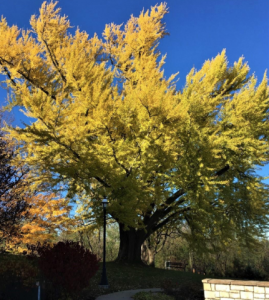Unlike … say … marigolds (which take only about eight weeks to go from seed to flower) trees take decades if not longer to mature. So any plan governing an urban canopy – a la “public” trees – requires a long-term, strategic approach with buy-in from residents.
With that in mind, Covington’s Urban Forestry Division is seeking to hire a consultant to help write a 20-year master plan that brings strategic thinking to the City’s historic investment in creating and maintaining its green infrastructure.

Legend has it that the legendary Kentucky statesman Henry Clay had a hand in this massive and ancient ginkgo tree being planted near Behringer-Crawford Museum in Devou Park.
“Too often, communities ‘wing it’ when it comes to trees,” said Cassandra Homan, the City’s Urban Forester in its Public Works Department. “That can lead to bad decisions, wasted money, and problems. Without a guiding plan, the wrong kinds of trees are planted in places where they cause problems, unrestrained clearing of hillsides can cause erosion, and poorly scheduled pruning and watering allows trees to die. Covington has proudly been identified as a member of Tree City USA for the past 16 years, and we want to retain this status.”
As part of its master plan process, the City wants to hear from its public. It is:
• Distributing a short online survey, available HERE.
• Seeking names and contact information of stakeholders and other interested parties to be part of more focused discussions. Those stakeholders should email Homan at Cassandra.homan@covingtonky.gov.
“Community involvement is important to the long-term success of this effort,” said Homan, who gave a presentation on the initiative to the Covington Board of Commissioners at its meeting this week.
The survey was created with the help of business students from Xavier University and Northern Kentucky University and the Covington Urban Forestry Board.
The RFP (request for proposals) can be accessed through the City’s Procurement Page HERE. Responses are due by 10 a.m. March 30.
Forestry overhaul
The master plan is part of a year-long, top-to-bottom look at the Urban Forestry Program, which was created in 2004.
That effort included an overhaul last summer of all ordinances, administrative regulations, and requirements to bring clarity to how the City governs trees in the public right of way, including how they relate to Historic Preservation, zoning, Public Works, and utilities.
It also included the creation and adoption of Urban Forestry Best Management Practices to guide planting, pruning, and removal of trees in Covington.
The urban canopy
Homan said the City has surveyed about 5,000 trees along its streets and the maintained areas of parks, not counting along its rivers and in the back-country area of Devou Park.
A genus study found almost 60 representatives. Unfortunately, the genus with the highest number of trees remains the invasive and problematic Callery pear, at 15.1 percent, a number the City continues to reduce.
Benefits
Trees not only beautify a community but also offer numerous environmental and health benefits, including some unexpected ones, Homan said. For example, trees:
• Slow down rain run-off and filter out pollutants, resulting in cleaner water.
• Filter out air pollutants, resulting in cleaner air.
• Absorb carbon, helping to mitigate the impact of climate change.
• Block sunlight, reducing the “urban heat island” effect and reducing the energy needed to cool buildings.
• Block street noise.
• Attract wildlife and pollinators.
Furthermore, more targeted studies show that communities with lots of trees have lower rates of disease, improved mental health, reduced crime, higher property values, and increased academic success, all byproducts of the “calming effect” that trees create, she said.
“There are many reasons to invest in trees,” Homan said.
















